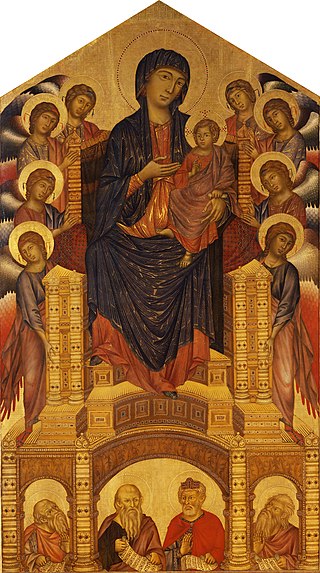
Cimabue, c. 1240 – 1302, was an Italian painter and designer of mosaics from Florence. He was also known as Cenni di Pepo or Cenni di Pepi.

A mosaic is a pattern or image made of small regular or irregular pieces of colored stone, glass or ceramic, held in place by plaster/mortar, and covering a surface. Mosaics are often used as floor and wall decoration, and were particularly popular in the Ancient Roman world.

Lorenzo Ghiberti, born Lorenzo di Bartolo, was an Italian Renaissance sculptor from Florence, a key figure in the Early Renaissance, best known as the creator of two sets of bronze doors of the Florence Baptistery, the later one called by Michelangelo the Gates of Paradise. Trained as a goldsmith and sculptor, he established an important workshop for sculpture in metal. His book of Commentarii contains important writing on art, as well as what may be the earliest surviving autobiography by any artist.

The Patriarchal Cathedral Basilica of Saint Mark, commonly known as St Mark's Basilica, is the cathedral church of the Patriarchate of Venice; it became the episcopal seat of the Patriarch of Venice in 1807, replacing the earlier cathedral of San Pietro di Castello. It is dedicated to and holds the relics of Saint Mark the Evangelist, the patron saint of the city.
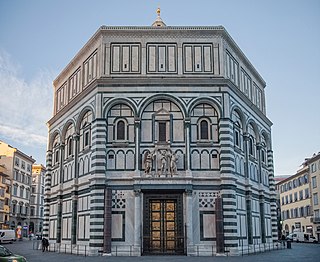
The Florence Baptistery, also known as the Baptistery of Saint John, is a religious building in Florence, Italy, and has the status of a minor basilica. The octagonal baptistery stands in both the Piazza del Duomo and the Piazza San Giovanni, across from Florence Cathedral and the Campanile di Giotto.

The Euphrasian Basilica or the Cathedral Basilica of the Assumption of Mary is a Roman Catholic basilica in the Istrian town of Poreč, Croatia. The episcopal complex, which comprises the basilica itself, a sacristy, a baptistery and the bell tower of the nearby archbishop's palace, is an excellent example of early Byzantine architecture in the Mediterranean region.

The Basilica of Saint Francis of Assisi is the mother church of the Roman Catholic Order of Friars Minor Conventual in Assisi, a town in the Umbria region in central Italy, where Saint Francis was born and died. It is a papal minor basilica and one of the most important places of Christian pilgrimage in Italy. With its accompanying friary, Sacro Convento, the basilica is a distinctive landmark to those approaching Assisi. It has been a UNESCO World Heritage Site since 2000.

A crux gemmata is a form of cross typical of Early Christian and Early Medieval art, where the cross, or at least its front side, is principally decorated with jewels. In an actual cross, rather than a painted image of one, the reverse side often has engraved images of the Crucifixion of Jesus or other subjects.

The Basilica of San Vitale is a late antique church in Ravenna, Italy. The sixth-century church is an important surviving example of early Byzantine art and architecture, and its mosaics in particular are some of the most-studied works in Byzantine art. It is one of eight structures in Ravenna inscribed on the UNESCO World Heritage List. Its foundational inscription describes the church as a basilica, though its centrally-planned design is not typical of the basilica form. Within the Roman Catholic Church it holds the honorific title of basilica for its historic and ecclesial importance.

Orvieto Cathedral is a large 14th-century Roman Catholic cathedral dedicated to the Assumption of the Virgin Mary and situated in the town of Orvieto in Umbria, central Italy. Since 1986, the cathedral in Orvieto has been the episcopal seat of the former Diocese of Todi as well.

Angoulême Cathedral is a Roman Catholic church in Angoulême, Charente, France. The cathedral is in the Romanesque architectural and sculptural tradition, and is the seat of the Bishop of Angoulême.

Coppo di Marcovaldo was a Florentine painter in the Italo-Byzantine style, active in the middle of the thirteenth century, whose fusion of both the Italian and Byzantine styles had great influence on generations of Italian artists.

Christ in Majesty or Christ in Glory is the Western Christian image of Christ seated on a throne as ruler of the world, always seen frontally in the centre of the composition, and often flanked by other sacred figures, whose membership changes over time and according to the context. The image develops from Early Christian art, as a depiction of the Heavenly throne as described in 1 Enoch, Daniel 7, and The Apocalypse of John. In the Byzantine world, the image developed slightly differently into the half-length Christ Pantocrator, "Christ, Ruler of All", a usually unaccompanied figure, and the Deesis, where a full-length enthroned Christ is entreated by Mary and St. John the Baptist, and often other figures. In the West, the evolving composition remains very consistent within each period until the Renaissance, and then remains important until the end of the Baroque, in which the image is ordinarily transported to the sky.

Pistoia Cathedral, or Cathedral of Saint Zeno is the main religious building of Pistoia, Tuscany, central Italy, located in the Piazza del Duomo in the centre of the city. It is the seat of the Bishop of Pistoia and is dedicated to Saint Zeno of Verona.

The Church of Santa Maria dei Servi is a Romanesque style, Roman Catholic church in the Terzo of San Martino in the city of Siena, Tuscany, Italy.

Italy has the richest concentration of Late Antique and medieval mosaics in the world. Although the art style is especially associated with Byzantine art and many Italian mosaics were probably made by imported Greek-speaking artists and craftsmen, there are surprisingly few significant mosaics remaining in the core Byzantine territories. This is especially true before the Byzantine Iconoclasm of the 8th century.

The Hetoimasia, Etimasia, prepared throne, Preparation of the Throne, ready throne or Throne of the Second Coming is the Christian version of the symbolic subject of the empty throne found in the art of the ancient world, whose meaning has changed over the centuries. In Ancient Greece, it represented Zeus, chief of the gods, and in early Buddhist art it represented the Buddha. In Early Christian art and Early Medieval art, it is found in both the East and Western churches, and represents either Christ, or sometimes God the Father as part of the Trinity. In the Middle Byzantine period, from about 1000, it came to represent more specifically the throne prepared for the Second Coming of Christ, a meaning it has retained in Eastern Orthodox art to the present.
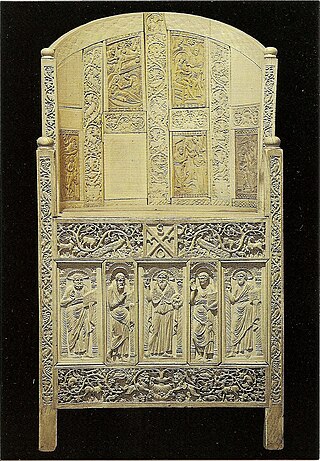
The Throne of Maximian is a cathedra that was made for Archbishop Maximianus of Ravenna and is now on display at the Archiepiscopal Museum, Ravenna. It is generally agreed that the throne was carved in the Greek East of the Byzantine Empire and shipped to Ravenna, but there has long been scholarly debate over whether it was made in Constantinople or Alexandria.
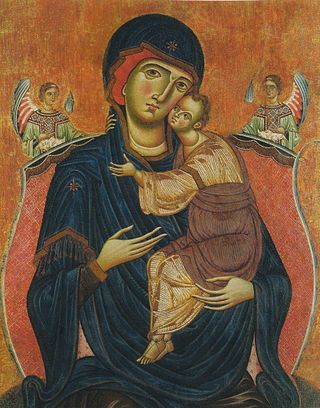
Meliore di Jacopo was a Medieval Italian painter from Florence.
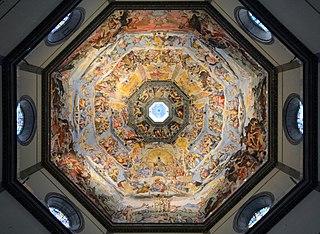
The Last Judgment in the Cattedrale di Santa Maria del Fiore, in Florence, Italy is a fresco painting which was begun by the Italian Renaissance master Giorgio Vasari in 1572 and completed after his death by Federico Zuccari, in 1579. Initially commissioned by Grand Duke Cosimo I de' Medici, it is located on the ceiling of the dome of the cathedral. It was the subject of an extensive restoration undertaken between 1989 and 1994.





























































































